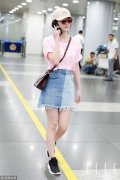Update Time:2018-09-27Click:257

The advent of internet and social media has revolutionized various sectors, and fashion isn't immune to this wave of change. No longer dictated solely by haute couturiers and fashion week runways, today the style choices of influencers on Instagram, TikTok, YouTube and other platforms have become major vehicles of fashion trends. Their crucial role in the fashion industry is worth examining.
In the constantly evolving digital era, influencers have emerged as potent fashion forces, shaping trends and steering style preferences. They are more than just social media personalities; they directly influence their followers' buying behaviors with every post they share, every outfit they wear, and every fashion brand they endorse.
More relatable than high-profile celebrities and thyrric models, influencers come across as the everyday person, building genuine connections with their followers. This relationship builds trust and allows for an impactful promotion of style choices. A well-loved influencer can popularize anything, from a modest local brand to a luxurious fashion house, transforming them into the next big trend.
Not confined to one demographic or geographic location, influencers are able to target and resonate with a diverse range of audiences. They also contribute to perpetuating individuality, fostering body positivity and promoting sustainable fashion C the trends that strike a chord with the global, conscious consumer.
Influencers also play a pivotal role in gendered fashion trends. Traditionally, fashion hues, styles, and materials have been gender-assigned. However, influencers push these boundaries, advocating unisex designs, and challenging conventional perceptions of masculinity and femininity. They subtly shift the narrative towards the understanding that fashion is a form of self-expression not bound by gender norms.
Moreover, influencers are transforming the way brands approach marketing. Instead of investing heavily in traditional ads, many brands now choose to sponsor influencers' posts or collaborate with them for special edition releases. Trusting an influencer's tastes and creative lens, followers are likely to accept and even emulate their style recommendations. This leads to increased brand visibility and sales.
However, there exists a flip side to this influencer-led fashion trend shaping. Critics argue that the influencer space, driven by likes, followers, and engagement rates, can perpetuate a 'fast fashion' mentality. Constantly showcasing new outfits and styles can inadvertently promote disposable fashion, a practice detrimental to the environment.
Influencers also bear the responsibility of endorsing authentic and trustworthy brands. As influencers sometimes promote products for pecuniary gains, the credibility of such endorsements often comes into question. Hence, a moral and ethical responsibility rests on influencers to present impartial and legitimate critiques or endorsements.
To sum up, the role of influencers in shaping fashion trends is profoundly significant and multi-dimensional. They serve as versatile fashion disseminators, meeting the style-savvy and tech-savvy interests of the modern-day consumer. In the digital marketing world, influencers operate at the intersection of fashion trends, brand promotion, social media, and customer behavior.
Moving forward, their influence is set to rise exponentially, supported by technological enhancements and evolving consumer preferences. This power of influence, however, should be harnessed responsibly. The ultimate goal should be paving the way for an inclusive, sustainable, and ethical fashion environment, reflecting the true spirit of fashion in its universal appeal and in inspiring individuality.
Title: "Does Higher Social Media Following Equate Greater Influence in Fashion Trends?"
In the world of social media, influencers have revolutionized the dynamics of the fashion industry. With every post targeted at their followers, they cultivate trends, impact purchasing behaviors, and enhance brand recognition. One of the pertinent questions that arises in this context is whether an influencer with a higher social media following wields a greater influence on fashion trends.
Intuitively, it might seem apparent that those with a larger following possess more influence. They have a broader reach, meaning their style, attitudes, and prefixed trends quickly disseminate among a wide audience. Each post they share has the potential to inspire millions, and every fashion piece they endorse has the possibility to see a surge in sales. Brands thrive on this vast outreach, often partnering with high-follower count influencers for product promotions or collaborations.
Furthermore, influencers with a substantial following often have a well-established persona reflective of a unique style or niche in fashion. This distinct identity allows them to set themselves apart from the crowd, making their fashion choices more alluring and their influence more substantial.
However, high follower count is not always indicative of stronger influence. An important aspect is the quality of the influencer's engagement with their audience. Higher engagement often translates into higher trust, rapport, and subsequently, impact. A micro-influencer with fewer followers but high engagement levels can have just as much, if not more, influence on fashion trends.
In fact, these micro-influencers often have niche, dedicated followers who trust their aesthetics and recommendations. Their smaller, more concentrated follower base can foster a close-knit community that shares similar fashion sensibilities, enabling micro-influencers to have a major sway over their followers' style choices.
The authenticity of an influencer also plays a pivotal role in determining their impact. Consumers today value genuine product experiences and reviews. Therefore, an influencer with a high follower count but low authenticity might find their influence waning. On the other hand, influencers who prioritize authenticity, regardless of their follower count, can have a significant influence on their audience's sartorial choices.
It s also important to consider that in an era marked by conscious consumerism, influencers advocating for sustainability and ethical fashion are gaining momentum. They may not always have the largest following, but their impact is forceful as they shape the narrative of fashion towards a more responsible and mindful direction.
In conclusion, while a higher follower count on social media might provide a broader platform to influence fashion trends, it does not necessarily equate to greater influence. Factors like engagement level, authenticity, niche appeal, and aligning with the new-age values of fashion also wield substantial power in influencing fashion trends. In the ever-evolving social media landscape, it's not merely about who has the most followers, but who leaves a lasting impact with their unique, authentic style and voice.

Exploring the Role of Influencers in Shaping Fashion Trends

Exploring Women's Fashion Styling

2024’s Top Fashion Trends: An Exclusive Look

Women's Fashion Styling: Comfort vs Style

Women's Fashion Styling: Fabric Types Used

Men's Fashion Styling: Importance of Fit

Exploring Men's Fashion Styling

Denim Decode Tracing the Ever-Evolving

Designer Spotlight Profiles of the Top Trendsetters in Fashion

Digitalization in Fashion The Next Big Revolution